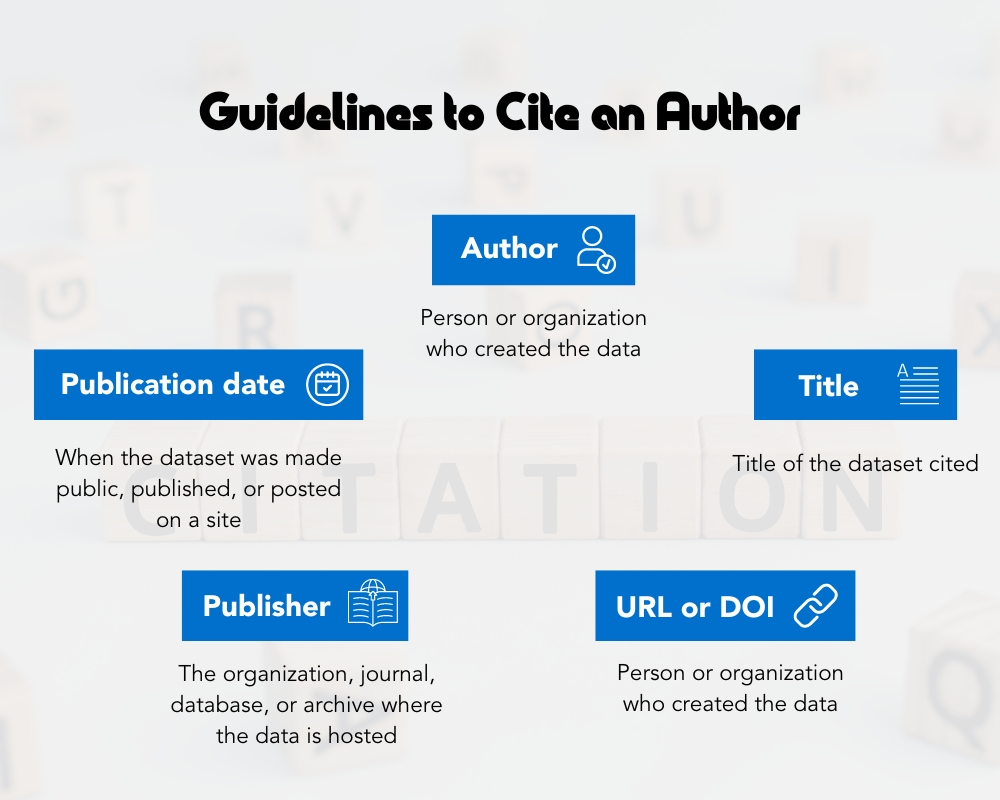When you are writing a research paper, sometimes you are required to use statistical data to back up your ideas in the paper. You’ll need to cite where you obtained the statistical information, or your instructor will conclude that it is copied work.
Citing the source of the information you retrieved will make it easy for your readers to check the data themselves if they’d like to. They will be able to verify the methods you used to collect your data set. Citing basic information is similar; however, the format will differ depending on your citation style.
General Guidelines to Cite an Author
Statistical tables and data sets have unique features that most citation styles need to address. When citing data sets and statistical tables, you must include at least the following information; however, your citation style will determine how you arrange the information.
- Author: this is the person or organization that created the data.
- Publication date: when the dataset was made public, published, or posted on a site.
- Title: it is the title of the dataset you are citing. If it does not contain a title, describe the data and, if possible, the period of the data.
- Publisher: this is the organization, journal, database, or archive where the data is hosted.
- URL or DOI: when you get the dataset in an online profile, a URL or DOI is the unique identifier of that site.
In some cases, a citation style might request additional information, such as the version or edition of the data, the date you accessed the data, and the data format.

Using In-Text Citation
You can use parentheticals or footnotes when creating in-text citations in your research paper. Parenthetical citations and footnotes are the most common methods of correctly citing information in your research paper.
Just so you know, parenthetical citations are mainly used in APA and MLA formats, while footnotes are used in Chicago format and other formats if instructed. They direct readers to information concerning the sources used.
The standard format for an in-text citation is; (Author, page number)

Citing Web Pages in Text
The lack of page numbers and sometimes the need for an author makes it a complicated business to create an in-text citation for a web page or eCommerce storefront. Please use the first item in your full citation when using the MLA format. This will make it easy for the reader to identify the full citation.
For example, when citing statistics data presented in a table, the in-text statistics citation for that data will be; (“Table 003.01”)
Statistics – It Seems Like a Lot of Information!
It is a limited amount of information since we are advised to use as much information as possible about the source if the information is available. This depends on your lecturer’s instructions since sometimes we are advised to leave some information out.
Your lecturer will give instructions on the format you will use to create the citations. Could you provide the necessary details to make it easy for them to find your source? Your sources should be good enough, reputable, and of high quality, and do not use common knowledge to back your statistics.

APA – The Full Citation Structure
APA style is one of the most used formats for referencing your sources when writing a research paper. The core components of an APA citation style include the following:
• Author; the author’s initials should be separated and ended by a period, and multiple authors should be separated using commas and an ampersand. Add the names of authors with the same surname and initials into brackets.
• Date: it refers to the date of publication, and if the date is unknown, you should use ‘n,d.’
• Title: the title format changed depending on what you are referencing.
• Publisher: This is the organization that published that source.
• URL: an URL is used if you have used an online source
How to Reference YouTube in APA Format
YouTube has a lot of informative videos, and this information can be cited in your research paper. When citing a YouTube video using APA style, you have to provide the following:
• Username, the full name or title of the company that uploaded the video
• Title of the video
• Website name (YouTube)
• Video publisher
• The date the video was uploaded
• Length of the video
• Video URL
The basic format is Author. (Year, Month Day). Title of Video [Descriptor]. Website. URL

Cite A Website in MLA Format
When citing a website, you choose a specific webpage on that website, but you are not citing the entire website. There are nine pieces of details crucial when creating a website citation in MLA, they are:
• Author
• “Title of the Source.”
• Title of the Container
• Other Contributions
• Version
• Number
• Publisher
• Publication Date
• Location.
The general format is Author’s Last name, First name. “Title of Web Page.” Title of Website, Publisher, Date published, URL.
How to Reference an Online Video in MLA Format
The internet is full of educative online videos you can use in your research paper. Some people need help citing online videos since they are not direct, like when citing a book or a blog article about industry stats. This is the crucial information you will need when citing an online video as one of your data sources.
• the author
• title
• contributors
• publisher
• date
• location
Choosing Data for your Reference List
I think your reference list should be well-detailed with all the sources that you have cited in your work. The list should be listed in alphabetical order. When choosing data for your reference list, you should use related data that supports your research paper.
The source of this data should be easy to find if your instructor wants to visit the source and learn more about your work. The data should be from a reliable and reputable source that states facts, not just common knowledge.



